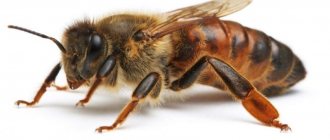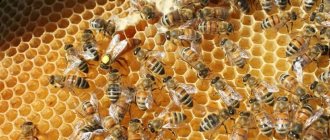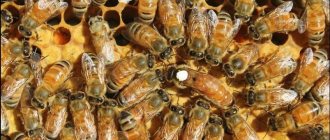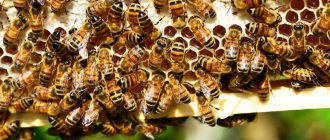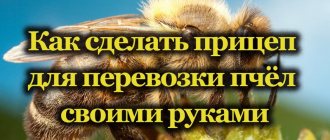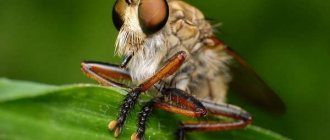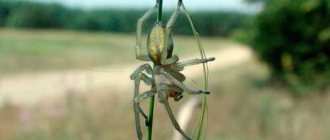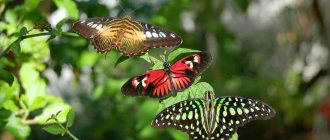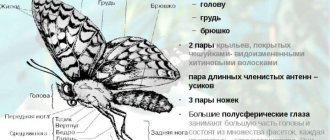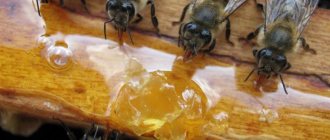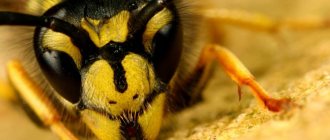Bees appeared as a result of natural and artificial selection, which people began during the development of beekeeping and beekeeping. Because of their honey, these insects are the most useful on the farm. Ancient people specially bred bees, and honey was used not only for food, but also as medicine. Bees live in different parts of the planet and are distinguished by their external characteristics, stability, productivity and other qualities.
Types of bees
At the moment, about 21 thousand bees are known, which are united in 520 genera. Let's consider the main ones:
Himalayan bee
They differ from Hymenoptera by their bright yellow-black body color. These representatives are most often found in mountainous regions. These insects are notable for the fact that they have a fairly calm character and are resistant to ticks. The honey from these bees is collected by the Gurung people of Nepal. It is noteworthy that their honey has hallucinogenic properties. This fact is due to the fact that in the territory in which they live there is a large number of rhododendrons. During the flowering period, these plants produce andromedotoxin, which is a strong poison. When it enters the human body, it contributes to the appearance of hallucinations.
Leaf Cutter Bee
The appearance of this bee is very similar to ordinary wasps. They have a body length ranging from 8 to 16 millimeters. They are distinguished by the presence of a strong jaw, thanks to which they can cut leaves. Leaf cutters feed on nectar. They can be found in latitudes where a temperate climate prevails. Over the course of a bee’s entire life, only 25 plants can be pollinated, since they have a rather short life cycle.
Bashkir bee
This species of bees is found in European countries. Their body color is gray without the characteristic yellow stripes. These insects have perfectly adapted to various climatic conditions, as they are able to fly out of the hive even in the cold.
Yellow Caucasian bee
These representatives are considered one of the most common breeds and are found in the mountains. They are capable of producing high-quality honey, but they tolerate cold extremely poorly and are endowed with poor immunity. About 7 percent of these bees have a swarming instinct.
Gray Caucasian bee
A distinctive feature of this bee is its gray color. The entire body lacks the yellow stripes that are characteristic of most bees. This representative is divided into several subspecies depending on its habitat: Abkhazian, valley, Kakheti, Imeretian and Megrelian. Insects of this species do not tolerate moving to places with a cold climate.
Italian bee
These individuals began to spread throughout the Apennine Peninsula. They are distinguished by gray, gold or three-stripe color. Golden bees are most often bred. Individuals of this species are large in size and have a trunk length of about 6.5 millimeters. Italian bees themselves are quite peaceful, but are aggressive in times of danger. It is quite difficult for them to live on the territory of Russia, since they endure winter with great difficulty.
Asian bees
Certain species of honey bees have spread to Asia. They have a number of characteristic differences. At the moment they number 9,000 species. The main representative is the large bee Apis dorsata laboriosa . In addition to their large size, the abdomen of these individuals is dark in color with white stripes. Between the main pairs of eyes there is an additional pair. These bees live on steep cliffs where they build their hives. Their bite is very painful.
Ukrainian steppe bee
Bees of the Ukrainian steppe breed are adaptive to serious temperature fluctuations, thanks to which they can tolerate wintering well. These bees prefer plants that are high in sugar. About 10% of all bees of this species are prone to swarming. They are also distinguished by good fertility and unique cleanliness, which is manifested in the fact that the hives of these bees are not clogged with debris and wax.
Don bee
This species is also characterized by fairly high fertility. Their color is represented by brown stripes. During the reproductive period, the queen lays about 3,000 eggs per day. However, members of the family are very prone to swarming. They feed mainly on the nectars of sweet clover, oregano and acacia.
Thai bees
The appearance of these bees is represented by a dark abdomen and the absence of characteristic stripes on the surface. Also, the wings of these bees are much darker. The insects themselves are distinguished by a calm character and a high degree of efficiency. Their honey is famous for its soft and pleasant taste.
Abkhazian bee
You can meet this bee in the mountainous regions of the Caucasus. They prefer to live on steep cliffs, which is why they are also called stone bees. They are widely used for breeding due to their delicious and unique honey. They are cultivated in the USA and Western Europe. This species is distinguished by its disproportionately long trunk.
Melipona bees
The peculiarity of this species is the absence of a sting. Instead, they actively use their scent glands. If attacked, the melipon bee can use its mandibles. These individuals are also notable for the fact that they do not have a specific division of labor. Their hives are similar to bumblebee nests. Melipona honey is widely used in the Yucatan Peninsula as the bees in this region produce the most delicious honey. A very small population has survived to this day.
Altai bee
This type of bee is quite rare. They are widely used in Altai to produce honey, which has a number of beneficial properties. This species is also particularly productive and carefully uses its food supply.
Siberian bee
These bees have spread throughout Siberia, making them quite frost-resistant. They are valued due to their high resistance to a large number of diseases. They are also distinguished by their rather large size and high degree of fertility.
Central Russian breed: characteristics
Central Russian bees are considered one of the largest. They have a dark gray body color without yellowness (Figure 8).
Figure 8. Features of Central Russian bees
They have high productivity, resistance to cold and disease. However, insects are quite aggressive in nature, and when working with them it is imperative to wear protective clothing. This breed is recommended to be bred in the northern regions, since in the south they swarm heavily and significantly reduce productivity.
general description
The appearance of bees is represented by a three-part body: head, chest and abdomen. The entire surface of the bees' body is covered with small hairs, one part of which serves the function of touch and is also connected with the nervous system. The most sensitive organ of bees is their antennae, which allow them to navigate in the darkness of their hives. Thanks to the presence of a movable jaw, bees are able to build large cells from wax, as well as collect pollen from plants and leave the closed cell.
Adult bees reach sizes from 12 to 15 millimeters. Their abdomen is represented by 6 segments, on which rather thin and elastic wings with transparent veins are attached. On the head of these insects there are two large ones, and on the crown of the head there are three more small ones, which are used to recognize polarized light, thanks to which they can navigate by the sun.
In the area of the back of the abdomen there is a stinging organ, which contains two poisonous glands and a sharp sting up to two millimeters in length. The shape of the sting allows it to easily penetrate the skin of an animal or person. When it hits, the bee injects its poison and then dies.
A bite from about five hundred or a thousand bees can be fatal. Adult individuals can reach very high speeds and can also move up to 4 kilometers from the hive territory.
Cuckoos
This species of bee lives in Australia and the southeastern regions of Asia. They are large in size and black and blue in color with shiny hairs. They do not build nests, but give offspring to relatives of the Amegillus genus. Cuckoo bees are slow and lazy, unable to collect pollen.
It is impossible to give an exact answer to the question: “What breeds of bees are the best?” Each breed has its own advantages and disadvantages, which makes it optimally suitable for certain conditions.
Based on the above information, we can conclude that the best bee breeds for the neutral, central zone of Russia are Central Russian and Carpathian.
Lifestyle
Bees differ from other insects in their large groups, which are represented by hives with a strict hierarchy and division of labor. Representatives of this hierarchy include the queen, drones and worker bees. In the society of bees, the queen is the main one, and worker bees are responsible for ensuring the functioning of the hive. Males serve only for procreation. The queen is solely responsible for the reproduction of offspring, and she is also the creator of the entire hive and is responsible for its improvement until the worker bees appear.
Carpathian bee (Apis mellifera carpatica)
Another breed of European honey bees is called Carpathian bees based on their place of origin and habitat. The predominant color of the Carpathian bee is gray. The insect is distinguished by a long proboscis, up to 7 mm, good winter hardiness, peaceful character and low sugar content in honey. The queens of this bee species lay up to 1800 eggs per day.
Features of the breed include the early readiness of worker bees to collect honey. However, with a lot of positive qualities, Carpathian bees also have a number of disadvantages. These include a tendency to take someone else's bribe if there is a shortage of flowering honey plants in the area, as well as the absence of any resistance to wax moths penetrating into the hive.
Lifespan of bees
The lifespan of bees largely depends on the territory of its distribution and place in the bee hierarchy. Worker bees do not live long. If she was born between spring and summer, then her life expectancy will not exceed one month. This is due to the fact that these bees are constantly working. Worker bees that are born in the fall live for about six months. As a rule, they survive the winter and live until spring to begin active work collecting honey and nectar.
Drones have an even shorter lifespan. On average, it is about 2 weeks. These insects are ready for fertilization almost immediately, and then die. The drones that survive are sent to their deaths, expelled from the hive.
The uterus leads in life expectancy. The average period of its serviceability is about 5 years. However, to do this, she must be very important in the hierarchy and constantly produce offspring.
Italian breed: photo
A characteristic feature of Italian bees is their unusual bright yellow body color, by which they can be easily distinguished from others (Figure 10). The queens are highly fertile, and insects have high resistance to disease and a fairly peaceful nature.
Figure 10. What the Italian breed looks like
They are highly productive, and during the honey harvest period they easily switch from plants that contain less nectar to those that have the opportunity to harvest a more abundant harvest. Insects secrete a lot of wax, but do not survive wintering well due to their low resistance to cold. That is why Italian bees are recommended to be bred only in the southern regions.
Bee nutrition
Almost all bees eat pollen and flower nectar. A special proboscis is used to extract it. Through it, the nectar enters the crop, where it is converted into honey. In the process of collecting pollen and nectar, flower pollination is of great importance. In search of plants, these insects are able to fly about 10 kilometers per day.
About the threat of extinction
According to the Federation of Italian Beekeepers, there is every chance that Italian bees are in great danger and may even become extinct. However, the breed is still bred and distributed throughout the planet. With one caveat: the number of bees born does not exceed the number of dead .
Important ! The main reasons that the breed is on the verge of extinction include unscrupulous care and the use of chemicals for treating flowers.
Bee Reproduction
The process of reproduction in bees is carried out by laying eggs. Fertilized eggs give birth to full-fledged bees. If there was no direct fertilization, then drones are born. In order for the offspring to be viable, the queen must be fertilized by drones from other families.
Queen bee development
Bee eggs go through three stages: larva, prepupa and pupa. If the number of bees in a family becomes very large, then swarming occurs. One part of the bees remains in the hierarchy with the queen, and the second part looks for a new place with a new queen.
Reproduction diagram of the queen bee
Honey collection
Italian bees have high productivity, which manifests itself mainly in the mid-to-late season. If the honey flow is not very strong, a family can bring up to 30 kg of product . When looking for new sources, bees show high entrepreneurial spirit - most likely, this is why they sometimes steal and attack other bee colonies .
“Italian” honey is of high quality, sealed in beautiful, smooth white honeycombs
The insects place the collected honey in the upper housing . After filling, they seal the body, and during the working process they release a lot of wax , and therefore the honeycombs, beautiful and neat, are rebuilt without problems.
Without good orientation, Italian bees can settle in a neighboring hive. When searching for their home, they use a color palette. In addition, it is important to remember that hives cannot be transported or rearranged, because insects have difficulty withstanding this kind of stress and may even die because of it.
We also note that bees are very hardworking and meek. They work from early morning and finish later than others. Sometimes they show affection for flowers of the same species.
Note ! If the weather is unfavorable (it rains or the temperature is quite low), then Italian women will not work. Until conditions improve.
Royal jelly
Propolis
Wax
Honey
Bee distribution area
You can meet bees almost everywhere, with the exception of places where there are no flowering plants. Bees prefer to inhabit mountain crevices, hollows of old trees and earthen burrows. The main criteria are protection from the wind and the presence of liquid near the hive. Often bees can live in the attics of houses or between walls.
At the moment, the number of bees around the world is rapidly declining. The main reason for this sharp decline in populations is still unknown, but most often it is due to human activity in destroying the natural habitat of insects, the frequent use of chemicals for fertilizers and changes in the Earth's climate.
Comparative table of varieties
| Breed | Main features | ||||
| Coloring | Proboscis length, mm | Wing length, mm | Discoidal offset | Body weight, mg | |
| Abkhazian | Silver | 6,3-6,8 | Negative | 90 | |
| Asian | Yellow-black | 4 | 6 | ||
| African | Dark gray, bright yellow | 5,45-7,04 | 8,2-9,5 | 110 | |
| Central Russian | Dark gray | 5,9-6,4 | 9,35-9,5 | Negative | 110 |
| Italian | Golden yellow | 6,4-6,7 | 9,31 | 113-210 | |
| Carpathian | Light gray | 6,5-6,7 | 9,33 | Positive | 210 |
| Krajina (Karnika) | Silver gray | 6,4-6,8 | 9,26 | Negative | 110 |
| Ukrainian | Light gray | 6,3-6,7 | Positive | 105-200 | |
| Far Eastern | Gray or gray with yellow | 6-6,8 | 8-9,3 | Neutral | 105-230 |
| Buckfast | Dark yellow | 6,8 | 9,5 | Positive | 110-210 |
Ukrainian steppe
A slightly more gentle analogue of the Central Russian breed, resistant to foulbrood, nosematosis, honeydew toxicosis, cold wintering and hot, even dry, summers. Unlike Central Russian women, Ukrainian women are much more peace-loving and less playful. Despite their ardent love for linden and buckwheat, they are more willing to accept forbs. They give a lot of honey.
How to identify:
Gray, even silver, lighter than Central Russian ones.
The signet is white.
Note: Ukrainian beekeepers claim that originally there were two more breeds on their territory - black (boletus) and gray-yellow (jaundice). Now only Polesie is considered a separate variety - with even higher winter hardiness and average honey production.
Yellow Caucasian
Yellow Caucasian.
Ideal for hot weather (sitting motionless, not ventilated, but feeling normal).
Honey plants change easily, they eat everything that comes under their proboscis.
The character is eccentric: they are peaceful towards the beekeeper, but weak families of forest bees like to bully. They love to steal other people's honey.
How to identify:
The wet signet is the calling card of the Caucasian bee breed.
The color is more yellow. They live in the valleys of Georgia, Azerbaijan, and Armenia.
Flaws:
- highly swarming - up to 100 queen cells and 12 swarms;
- overcomes nosematosis and honeydew toxicosis;
- low honey productivity (up to 45 kg);
- designed for short and not cold winters.
